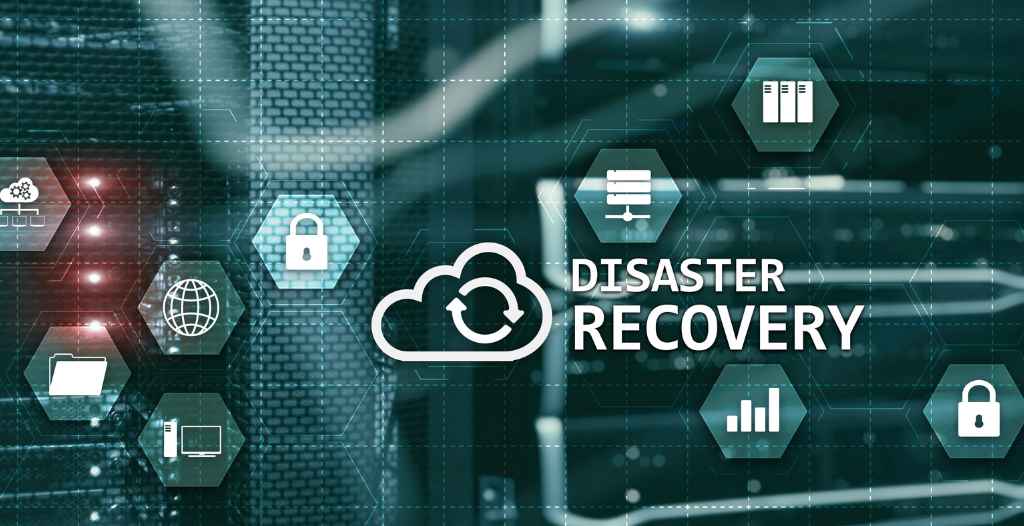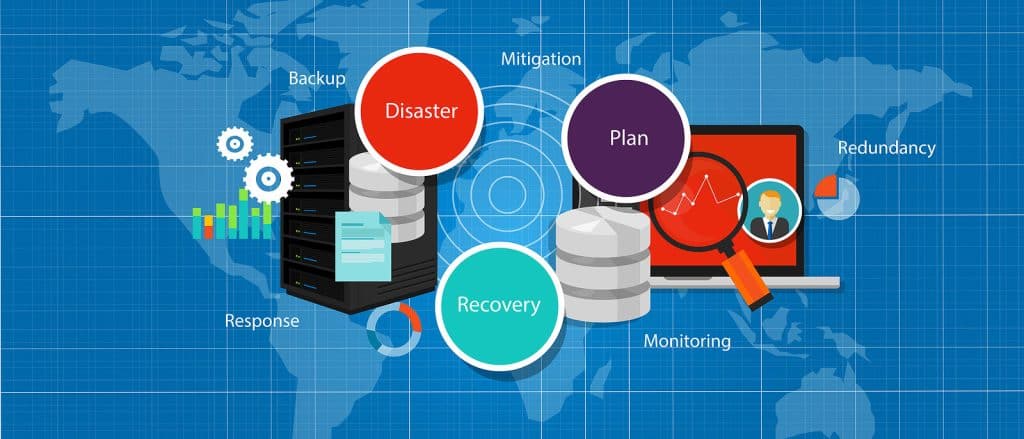If you think it’s unlikely that a disaster will hit your business, then think again. Disasters aren’t just caused by big natural events – they can also be caused by cyber-attacks, badly executed upgrades, and malicious employees.
Table of Contents
ToggleOrganizations that ignore preparing for disaster recovery are unlikely to survive when the unexpected happens. Learn more about the components of disaster recovery that you need to protect your organization.
1. Introduction to Disaster Recovery
What is Disaster Recovery?
Disaster recovery (DR) refers to the strategic plan and processes established by an organization so that it can recover its IT systems from unexpected events that cause significant disruption to business operations.
These events include man-made incidents and technical failures, as well as natural disasters.
Why is disaster recovery important?
Disasters will create different kinds of organizational damage depending upon the circumstances.
For example, a short network outage could stop e-commerce systems from working. High winds could damage data centers, leading to a complete loss of systems.
The costs of disasters can be substantial. The Uptime Institute estimated that 40% of outages cost from $100K to $1.5 million.
What is a Disaster Recovery Plan?
A disaster recovery plan (DRP) is a documented, structured approach with instructions for how to respond to unexpected incidents that affect business operations.
The plan, created by disaster recovery planning, focuses on restoring an organization’s IT operations as quickly as possible after a disaster.
2. What is a Disaster Recovery Strategy?

Effective disaster recovery strategies are crucial for the resilience of any organization. Tailoring these strategies to the specific needs and risks of the business is essential for ensuring rapid recovery and minimal disruption. Here’s an expanded look at what should be included in a disaster recovery strategy:
Regular Backups
- Comprehensive Data Protection: Regular backups involve protecting all critical data, ensuring nothing essential is left vulnerable.
- Varied Storage Options: Storing backups in diverse locations, such as on-site for quick access, off-site for added security, and in the cloud for scalability and flexibility, provides a robust safety net.
- Automated Backup Systems: Implementing automated backup systems ensures data is backed up consistently and reduces the risk of human error.
Diverse Replication Methods
- Enhancing Data Availability: Replication to off-site locations is vital for data availability, especially in events where the primary site is compromised.
- Cloud Replication: Utilizing cloud disaster recovery can offer rapid data restoration and minimize data loss, crucial for businesses with high data sensitivity.
- Real-Time Replication: Implementing real-time or near-real-time replication can significantly reduce the RPO.
High Availability Systems
- Minimizing Downtime: These systems are designed to ensure continuous operational capability, significantly minimizing potential downtime.
- Redundant Systems: Incorporating redundant components or systems to avoid single points of failure is a key feature of high-availability systems.
- Failover Mechanisms: High-availability systems often include failover mechanisms, allowing for seamless switching to backup systems without interrupting services.
Multi-Site Deployment
- Risk Diversification: Deploying critical systems across multiple data centers spreads risk and reduces the impact of a single site failure.
- Load Balancing: This strategy often includes load balancing, which not only helps in disaster scenarios but also optimizes performance during normal operations.
- Geographical Considerations: Choosing data center locations in different geographical areas can protect against regional disasters.
Regular Testing and Updates
- Verifying Plan Effectiveness: Regular testing of the disaster recovery plan is essential to ensure its effectiveness and to identify any weaknesses or gaps.
- Simulated Disaster Scenarios: Conducting simulated disaster scenarios can provide valuable insights into the readiness of the organization and the disaster recovery plan.
- Continuous Improvement: Regular updates to the disaster recovery plan based on test results and changing business needs are crucial for maintaining its relevance and effectiveness.
3. Disaster Recovery Planning

A robust disaster recovery plan should include several key components:
Internal and External Communication: Clear communication channels must be established within the team responsible for disaster recovery and with external stakeholders. This ensures everyone understands their roles and responsibilities during a disaster.
Recovery Time Objective (RTO) and Recovery Point Objectives (RPO): These objectives define the maximum acceptable time for restoring operations at disaster recovery sites (RTO) and the maximum acceptable duration of data loss (RPO).
Data Backup Strategies: Regular data backups are essential. This can include cloud disaster recovery solutions, offsite backups, and using multiple data centers.
Disaster Recovery Sites: These are locations where operations can be resumed after a disaster. They can be internal, external, or cloud-based.
Testing and Regular Updates: Regular disaster recovery testing is crucial to identify and rectify gaps in the plan.
Crisis Management and Business Continuity: The plan should align with the broader business continuity planning, ensuring that critical business operations can continue during and after a disaster.
4. Roles of a Disaster Recovery Team

The disaster recovery team is pivotal in managing and executing the disaster recovery plan. This specialized team’s diverse roles ensure that all aspects of recovery are comprehensively covered:
Crisis Management
- Immediate Response: The team initiates immediate actions in response to a disaster, prioritizing life safety and asset protection.
- Coordination of Recovery Efforts: They oversee the coordination of all disaster recovery work, ensuring efficient use of resources and timely execution of recovery processes.
- Decision-Making: This role involves critical decision-making under pressure, often requiring rapid assessment of complex situations.
IT Specialists
- System Restoration: IT specialists focus on the technical aspects of disaster recovery, including restoring IT systems and retrieving lost data.
- Technical Troubleshooting: They are responsible for identifying and resolving technical issues that arise during the recovery process.
- Ensuring Data Integrity: A key part of their role is to ensure that recovered data is complete, accurate, and free of corruption.
Communications
- Internal Communication: Managing communication within the organization is crucial to maintain morale and ensure that all employees are informed of the situation and recovery efforts.
- External Communication: This involves communicating with external stakeholders, including customers, suppliers, and the media, to maintain the organization’s reputation and customer trust.
- Crisis Communication Strategy: Developing and implementing an effective crisis communication strategy is vital to handling public relations during a disaster.
Business Continuity Planning
- Alignment with Business Strategy: Ensuring that the disaster recovery plan aligns with the broader business strategy and objectives.
- Minimizing Business Interruption: The team works to minimize disruptions to business operations and ensures that critical functions can continue or resume quickly.
- Continuous Improvement: They are also responsible for continuously updating and improving the business continuity plan based on lessons learned from disaster recovery exercises and actual incidents.
Each member of the team plays a crucial role in ensuring that the organization can effectively respond to and recover from disruptive incidents.
The effectiveness of the disaster recovery plan largely depends on the competence and coordination of this team.
5. Understanding Recovery Point Objective (RPO) and Recovery Time Objective (RTO)
In disaster recovery planning, two crucial metrics are particularly significant: RPO and RTO.
Far from being mere technical terms, these metrics are vital tools that aid organizations in shaping their disaster recovery strategies.
They serve as key indicators for defining how disaster recovery plans should be structured and executed.
Recovery Point Objective (RPO): RPO is the point in time before the disaster at which data can be successfully recovered, e.g. The most recent reliable backup that must be recovered for normal operations to resume. The RPO gives an indication of the amount of data at risk of being lost.
Recovery Time Objective (RTO): RTO is the targeted duration within which a business process must be restored after a disaster to avoid unacceptable consequences. It helps determine the minimal level of services needed to keep the business viable.
6. The Role of Cloud Disaster Recovery
Cloud Disaster Recovery (Cloud DR) represents a transformative shift in how businesses approach and manage their disaster recovery strategies.
Its increasing popularity stems from a blend of technological advancements and practical benefits, making it an attractive option for organizations of all sizes.
Flexibility and Scalability
- Adaptable Solutions: Cloud DR offers adaptable solutions that can be customized to fit the specific needs of a business. This flexibility ensures that companies can adjust their disaster recovery strategies as they grow or as their needs change.
- Scalable Resources: One of the primary advantages of cloud services is their scalability. During a disaster, resource requirements can fluctuate, and cloud DR allows businesses to scale their resources up or down as needed, ensuring efficient use of technology and cost.
Cost-Effectiveness
- Reduction in Physical Infrastructure: By leveraging cloud services, businesses can significantly reduce their investment in physical infrastructure. This not only lowers initial capital expenditure but also reduces ongoing costs related to maintenance and upgrades.
- Pay-as-You-Go Models: Many cloud providers offer pay-as-you-go models, which means businesses pay only for the resources they use. This approach offers a more economical solution compared to traditional disaster recovery methods.
Rapid Deployment
- Quick Implementation: Cloud DR solutions can be deployed rapidly, which is crucial in a disaster scenario where time is of the essence. The speed of deployment ensures that businesses can get their operations back online quickly, minimizing downtime.
- Pre-configured Solutions: Many cloud DR services come with pre-configured solutions that further expedite the deployment process, allowing businesses to focus on other critical aspects of their recovery efforts.
Geographical Distribution
- Mitigating Single Point of Failure: With cloud services often hosted in multiple locations, the risk of a single point of failure is greatly reduced. This geographical diversity is essential for protecting against region-specific disasters.
- Enhanced Data Protection: Multiple sites mean that data can be replicated in several locations, enhancing data protection and providing a robust defense against loss of data.
Recovery as a Service (RaaS)
- Comprehensive Disaster Recovery Solutions: RaaS encompasses a range of services that include not just cloud infrastructure but also professional disaster recovery services. This provides businesses with a comprehensive solution that covers all aspects of disaster recovery.
- Expert Support: RaaS often includes access to experts who specialize in disaster recovery. This support can be invaluable, especially for businesses that may not have in-house expertise in this area.
7. Business Impact Analysis in Disaster Recovery
Business Impact Analysis (BIA) is a foundational element of comprehensive disaster recovery planning. It acts as a diagnostic tool, offering insights into the potential effects of disruptions on an organization’s operations. Here is an expanded view of its critical components:
Assessment of Business Functions
- Detailed Evaluation: BIA involves a thorough evaluation of all business functions, assessing how each area contributes to the overall operations.
- Identifying Dependencies: It also identifies dependencies between various business functions, revealing how disruptions in one area can cascade to others.
- Impact Scoring: BIA typically includes assigning impact scores to different functions, helping to quantify the effect of disruptions.
Prioritization
- Ranking of Critical Operations: BIA aids in ranking business operations based on their criticality to the organization’s survival. This ranking is crucial for focusing resources and efforts during a recovery.
- Determining Maximum Allowable Downtime: For each critical function, BIA helps determine the maximum allowable downtime, which becomes a key input for setting Recovery Time Objectives (RTOs).
Resource Identification
- Resource Requirements: BIA identifies the resources — including personnel, technology, information, and physical space — required for maintaining or quickly resuming critical functions.
- Guiding DR Objectives: By understanding the resource needs, organizations can more effectively establish RTOs and RPOs, ensuring that these targets are realistic and achievable.
- Budget Allocation: The insights from BIA can guide budget allocation, ensuring that funds are directed towards protecting the most critical aspects of the business.
Integration with Risk Management
- Risk Assessment Alignment: Integrating BIA with broader risk management processes ensures a more comprehensive approach to understanding and mitigating potential disruptions.
- Customized Recovery Strategies: The detailed insights from BIA allow organizations to develop customized disaster recovery strategies that address the specific risks and impacts identified.
Continuous Improvement
- Regular Reviews and Updates: BIA is not a one-time activity but should be reviewed and updated regularly to reflect changes in the business environment, operations, and emerging threats.
- Driving Organizational Resilience: Continuous improvement of the BIA process contributes significantly to enhancing the overall resilience of the organization.
8. Testing and Optimizing Your Disaster Recovery Plan
Regular testing is crucial to ensure the disaster recovery plan’s effectiveness:
- Identifying Weaknesses: Testing reveals weaknesses and gaps in the plan, allowing for timely improvements.
- Ensuring Team Preparedness: It helps in assessing the disaster recovery team’s readiness and ensures that all members are aware of their roles.
- Evolving with Technological Changes: Regular updates are necessary to align the disaster recovery plan with current technologies and business processes.
- Documentation and Compliance: Maintaining updated documentation is key for compliance and audit purposes.
9. What is an example of Disaster Recovery?
In this scenario, a severe storm causes a power outage at a large corporation’s data center. This disrupts critical applications, so the company initiates its disaster recovery plan. Key steps include:
- Activation of the Disaster Recovery Plan: The DR team is mobilized immediately following the outage detection.
- Assessment and Communication: The team assesses the outage’s extent and communicates with stakeholders, including management, employees, and customers.
- Switch to Backup Systems: Operations are shifted to a secondary data center in a different location, ensuring minimal service disruption.
- Data Restoration: Critical data is restored from recent backups.
- Remote Work Enablement: Employees are directed to work remotely, with the IT department ensuring secure and operational remote access systems.
- Repair and Recovery: Technicians work on restoring the primary data center, assessing and repairing any damage.
- System Checks and Validation: Before transitioning operations back, comprehensive checks are conducted to ensure all systems at the primary data center are functional.
- Transition Back to Primary Data Center: Operations are gradually moved back from the backup site to the primary data center after validation.
- Review and Analysis: The disaster recovery team reviews the event and the response’s effectiveness, integrating lessons learned into the disaster recovery plan.
- Communication of Resolution: Stakeholders are informed about the incident’s resolution and the return to normal operations.
10. Conclusion
Disaster recovery is a critical component of contemporary business strategy, ensuring operational resilience and business continuity.
As organizations experience an increasingly complex and threat-prone digital landscape, having a comprehensive disaster recovery plan becomes not just a safeguard, but a competitive necessity.
This enables businesses to quickly respond to and recover from disruptions, minimizing downtime, protecting assets, and maintaining customer trust.
By having effective disaster recovery strategies integrated with the business, organizations are better prepared to handle unexpected challenges.




